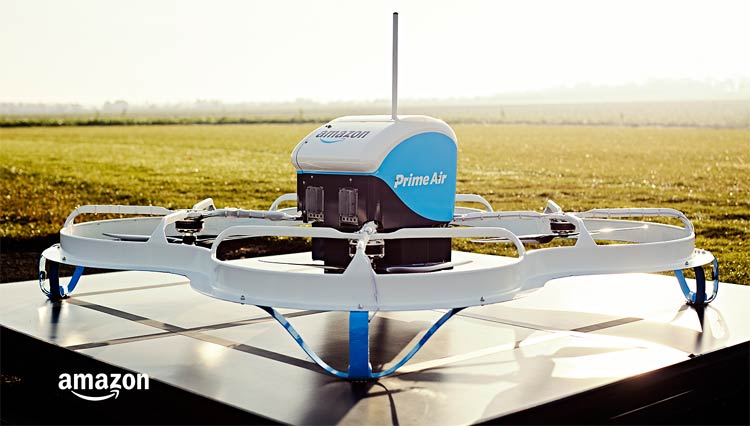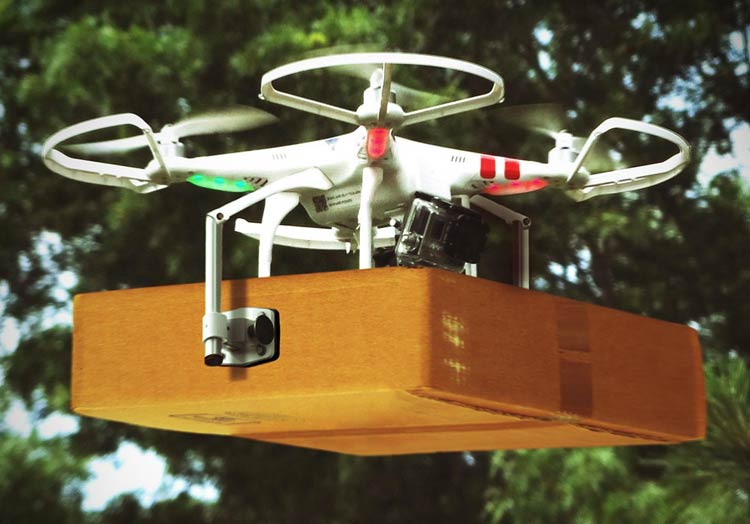While most of us continue to complain about the traffic congestion on the road, tech companies have already entered the air mobility space for faster and smoother conveyance. This has paved the way for the revolutionary drone-driven package delivery systems in various industrial applications.
Most of today’s scientific discoveries and technological advancements revolve around the heightened need for convenience. Similarly, the modern-day package delivery systems are undergoing an electronic transformation as demands of digitally-connected consumers have evolved with time. We are entering the era where package deliveries through drones are not just an idea from any fiction. In fact, we are not too far away from the time when e-commerce or supply chain management companies will commence package delivery services with drones.
Most e-commerce companies and parcel delivery businesses are pushing their operational limits to reduce package delivery time. With ongoing research & development activities in the field of drone technology, the potential to improve speed and reduce delivery time has increased to a new extent. As a result, a mounting number of industries are on the verge of embracing drones for package delivery.
Does that mean, soon, your food will be delivered through drones? Would drones flying for delivering groceries become a common picture in the coming years?
The Ground Reality about Delivery Drones in Supply Chains
Amazon is enjoying first mover’s advantages in this landscape with its revolutionary drone delivery module – Amazon Prime Air. In a few months from now, autonomous and fully electric Prime Air drones are likely to commence delivering packages to consumers with the shortest delivery time possible.
Amazon’s Prime Air drones are capable of delivering packages that weigh up to five pounds and can fly up to 15 miles, keeping the delivery time less than 30 minutes. While most e-commerce businesses remain skeptical about the feasibility and practicality of delivery drones, Amazon has announced that drones could technically handle between 75% and 90% of its package deliveries in the coming years.

United Parcel Service (UPS) is another multinational package delivery and supply chain management company that has already conducted an experience with using drones for delivering medical packages in the United States. UPS has joined forces with a California-based autonomous delivery drone startup – Matternet to design and develop cargo drones that can have potential beyond medical package delivery.
While Amazon and UPS are among the leading companies to have carried out experiments to gauge the commerciality of drone package deliveries, they are certainly not the only ones. The attractive growth parameters of the drone technology are encouraging tech giants like Google to enter this landscape. A mounting number of global leaders as well as start-ups and small businesses in the technology industry, investing heavily in the development of the next-generation features of the drone technology.
Advancements in Unmanned Aerial Vehicles (UAV) Technology
The world remains highly curious about the variety of functions carried out by and the capacity of delivery drones to travel a long range of distances, recent developments in technologies continue to push the enormity of their potential.
With the advent of technologies such as Artificial Intelligence (AI) and the Internet of Things (IoT), autonomy has become a possibility in designs of cargo drones, pushing their efficiency to a new high. This reflects in the dominance of the autonomous delivery vehicles (ADVs) technology in this regard, and the enormous potential for advancements in ADVs carries the power to disrupt the whole drone delivery industry.
The current scenario vis-à-vis the cargo drones technology reflects in a mounting number of companies testing and experimenting with their rollout of last-mile delivery technologies with state-of-the-art drones. UAVs and unattended delivery technology are emerging as the first wave of development in the drone delivery industry, which is currently transforming the last-mile logistics in supply chain management.
However, technological developments in this landscape are faster than expected, and leading market players are set to bolster technology piloting at every stage of package delivery and last-mile logistics. In the coming years, technologically advanced, package-delivering robotic dogs are likely to be tested, leading to a future of fully autonomous delivery vehicles running on roads.
Drone delivery technology, the pace at which is it evolving, is expected to give rise to modules that may eliminate the need for human assistance in package delivery. Furthermore, market players are expected to focus on improving the affordability of cargo drones and delivery robots to boost their widespread deployment in the coming decade.
Drone Delivery Challenges- Drones Cannot Take Over the Conventional Package Delivery System
While a mounting number of tech giants are voicing the profitability and feasibility of package delivery drones, the possibility of the skies full of cargo drones is still in the future. Package delivering drones and robots are in their nascent stages, and there are various hurdles in their way to the mainstream of supply chains.
The existing regulations about the use of air space for commercial purposes through delivery drones, air taxis, and other ADVs and UAVs present formidable challenges for businesses in this landscape. According to the regulatory framework established by the Federal Aviation Administration (FAA), drone flight is only limited to a pilot’s line of sight. It also restricts delivery drones from operating over crowds or people, and thereby, they need to be only flown over 400 feet by someone who has a remote pilot certificate.
The hurdles don’t end here. As cargo drones are built on next-generation technologies such as AI and IoT, their vulnerability to cyber threats is making consumers doubtful about their efficiency in terms of safety, privacy, and reliability. This may lead to exposing the drone delivery industry to many more legal and regulatory barriers in the coming years. Uncertainties about the future amendment in these regulations along with other functional constraints such as landing space, payload, costs, and security may create a roadblock for the use of delivery drones at a commercial scale.












